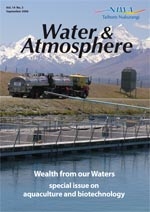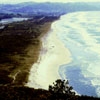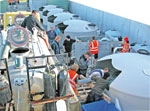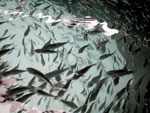PDF of this article (247 KB)




The greatest potential for rapidly adding value to our seafood industry is through the production of higher-value aquaculture species. Michael Bruce takes us through the kingfish example.
In the past two decades, the GreenshellTM mussel industry has grown from small pioneer beginnings to become one of New Zealand’s most valuable seafood exports. NIWA believes there is the opportunity to repeat this economic success on a larger scale by developing new higher-value aquaculture species. This strategy will make New Zealand’s aquaculture industry more secure through diversification and by reducing its reliance on the big three: mussels, Pacific oysters, and king salmon. Using higher-value aquaculture species will also help make better use of our existing marine farm space. For example, it has been estimated that the returns from finfish farming can be about $4 million per hectare of farm space, compared to about $30 thousand per hectare for mussels. The advantage of higher-value aquaculture species is part of the reason Australia’s overall aquaculture production is worth ten times New Zealand’s, earning over $20 000 per tonne compared to our $2000 per tonne.
Adding value with new species
Much of NIWA’s aquaculture R&D, together with our aquaculture industry collaborators, aims to identify and develop new aquaculture species. These include paua, rock lobster, kina, sea cucumbers, eels, sea sponges, seaweeds, and groper. In terms of commercial development, our most advanced new species is kingfish. The pathway we have followed for developing kingfish aquaculture demonstrates the steps along the way and highlights the challenge of reaching commercial success through a sequence of applied research and development projects.
Path to success: the kingfish story
Our kingfish research began in 2000. We made initial market appraisals and Moana Pacific Fisheries Ltd, in Auckland, expressed commercial interest in securing a cultured supply of kingfish. An extensive review of the biological information on kingfish convinced us that not a lot was known about the New Zealand species, but what was known was generally positive for aquaculture: kingfish are fast growing, communal, and suffer few natural diseases. Within the first year we had captured some large broodstock fish from the wild and worked out how to transport them alive and then acclimatise them to captivity. Our success at this was rewarded early: the fish spawned in captivity in their first year and have continued to do so ever since.
Despite this early success, to ensure the production of top quality eggs and their successful natural fertilisation under captive conditions, we have had to carefully study every aspect of the fish and their holding environment. To do this, we have monitored and manipulated their diet, water temperature, lighting, stocking density, sex ratio, water quality, and health.
Rearing baby fish from fertilised eggs is also very complex; high-quality fingerlings only result from delivering precise combinations of water quality, rearing systems, and good quality live and artificial foods to the different development stages from egg to fingerling. With any new finfish species, adept husbandry, together with painstaking research, is crucial for advancing these early rearing methods to efficient mass production.
Fingerlings on the move
In 2002 NIWA successfully produced a few hundred kingfish fingerlings. In 2003 we produced a thousand fingerlings; in 2004 it was tens of thousands; and in 2005–06 several hundred thousand high-quality fingerlings were produced. Scaling up fingerling production to commercially viable quantities has involved working out new and more efficient methods of rearing and feeding the rapidly growing fish.
Once we were able to provide sufficient quantities of kingfish fingerlings for commercial ongrowing, we faced a further series of obstacles to resolve through research. We devised innovative techniques for transporting kingfish fingerlings based on knowledge gained from many years of shipping millions of salmon fingerlings from NIWA’s hatcheries to salmon farms. Using these new methods, we have now moved hundreds of thousands of kingfish fingerlings by truck – from NIWA’s Bream Bay Aquaculture Park to farms as far away as the Marlborough Sounds and the Far North – with negligible losses.
Ongrowing kingfish requires an understanding of feeding and maintaining the fish in the best possible health, while also ensuring minimal impact on the environment from the farming activity. NIWA has been working with commercial kingfish ongrowers over the past two years, using research results to assist in overcoming production obstacles and inefficiencies. As a result, the first farmed kingfish from New Zealand went to market with good prices, paving the way for further rapid growth for this new aquaculture species. Our ongoing research with industry partners, such as Island Aquafarms Ltd, helps to further improve the efficiency and scale of production.
Capitalising on lessons learned
NIWA aims to continue to support the development of the kingfish aquaculture industry, while using the pathway it has built for advancing other new aquaculture species. We can now easily apply the facilities, expertise, and experience of working with kingfish to rapidly advancing other potentially high-value finfish aquaculture species – such as groper, butterfish, and tuna – for the benefit of New Zealand.
Putting something new on the menu
- As demonstrated by the success of GreenshellTM mussels, culturing new species is key to growing NZ’s seafood industry.
- Aquaculture R&D must resolve aspects of habitat, nutrition, breeding, and transport before a species can be grown in commercial quantities.
- NIWA’s experience in culturing kingfish demonstrates the steps along the path to success.
Overcoming deformities
Uneven growth in early fish stages is a common problem in developing methods for rearing new species of finfish from eggs. The uneven growth frequently results in skeletal deformities, such as a bent backbone or a drooping jaw. Fish with these deformities often survive, but grow poorly once moved to fish farms. Therefore, it’s important to prevent deformities occurring during the early rearing of baby fish.
When NIWA first began rearing kingfish, the proportion of deformed fish indicated that the production techniques needed further improvement. Research has shown that the uneven growth can be caused by a huge variety of different factors, including tank size, water quality, food availability, rearing density, oxygen deficiency, nutritional deficiencies, and poor egg quality. Pinpointing the cause in our kingfish required some detailed detective work, but the problem was quickly solved by NIWA researchers, and deformities in our juvenile kingfish are now at very low levels.
Dr Michael Bruce, who is based at NIWA in Auckland, is one of the leaders of NIWA’s National Centre for Fisheries & Aquaculture. Contact Michael at [email protected].
Teachers’ resource for NCEA AS: Biology 90461 (2.5), 90769 (2.2), Level 2 US6309, Level 1 US6299 Geography 90204 (1.3) Science 90187 (1.2), Level 3 US8153, US21613 See other curriculum connections at www.niwa.co.nz/pubs/wa/resources
